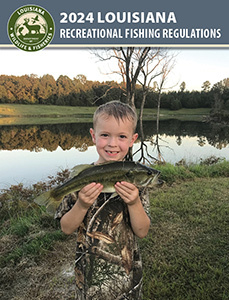Fish Consumption Advisories
Fish are a lean and nutritious source of protein. However, some fish may contain chemicals that could pose health risks. Louisiana fish consumption advisories are based on the estimate that the average Louisiana resident eats four fish meals per month (a meal is considered to be 1/2 pound of fish for adults and children). If you or your family members eat more than four meals of fish a month from local water bodies, you might increase your health risks.
The following information on fish consumption advisories has been furnished by the Louisiana Department of Health (LDH). LDH, Department of Environmental Quality and Louisiana Department of Wildlife and Fisheries coordinate in the issuance of advisories.
Unless the fish species is specifically addressed in the details of these advisories, please limit consumption of all species in an advisory area to four meals per month. You can contact the Office of Public Health toll free at 1-855-229-6848 for more information about eating fish that contain chemicals.
Readers should be aware that the information provided is a summary of the information available at the time of printing. Advisories may be changed or added at any time.
Contaminants in Fish
Almost everywhere you look in Louisiana there is water, and where there is water, people catch and eat fish. However, in a few Louisiana waters, fish and shellfish have chemical contamination in amounts that may be harmful to your health if you were to eat too much over a long period of time.
These contaminants are in the environment because of various reasons such as natural deposition, industrial discharges, leaking landfills and misuse of pesticides. Fish take in the contaminants from water, sediments and food. Larger, older fish and fish that eat other fish tend to accumulate more contaminants than smaller, younger fish.
The Office of Public Health evaluates chemicals in fish to determine if the fish are contaminated and pose a health threat to children, pregnant women, adults or (when indicated) subsistence anglers. A fish consumption advisory is issued when unacceptable levels of chemical contaminants have been found in the fish filet.
Fish Consumption Advisory
Fish consumption advisories in Louisiana are based on chemical levels in the fish filet. Advisories are issued at very conservative levels to insure the safety of individuals consuming fish. Advisories provide guidance regarding fish consumption for each species of fish. They do not tell you to stop fishing or to stop eating fish. Just be selective about the fish you or your family eats. None of the fish in Louisiana are contaminated enough to cause harm after a single or a few meals. The health risk comes from eating contaminated fish often and regularly over a long period of time.
A “meal” is considered to be 1/2 pound (8 oz.) in size. Unless the fish species is specifically addressed in the details of the advisory, please limit consumption of all species in an advisory area to four meals per month. Louisiana fish consumption advisories are based on the estimate that the average Louisiana resident eats four fish meals per month. If you or your family eat more than four meals of fish a month from local water bodies, you might increase your health risks. You can contact the Office of Public Health toll free at 1-888-293-7020 for more information about eating fish that contain chemicals.
Health Advice and Guidelines
Contaminants found in Louisiana fish can be grouped into two categories: organic chemicals (HCB, HCBD, PCBs and Dioxin) and metals (mercury, lead). Organic contaminants build up in fish fat deposits and just under the skin, more than in the muscle tissue (filet). Metals are distributed evenly throughout the fish and cannot be removed from the filet by cooking or cleaning.
How to Reduce Organic Chemical Contamination in Fish
- Remove all organs and skin. Organs and skin can be high in fat and organic chemicals.
- Trim off fatty areas. This includes belly fat, side fat and back fat. Organic contaminants concentrate in fat.
- Bake or broil skinned, trimmed fish on a rack or grill so fat drips off. Throw away drippings.
- When fish are poached or fried, throw away the broth or oil. Keep smaller fish to eat. Usually, younger, smaller fish are less contaminated than larger, older fish.
- Eat fewer predator fish such as bass, gar or pickerel. Contaminants bio-accumulate in predator fish.
- Vary diet by eating a variety of fish, shellfish, meat and poultry.
- Vary source of fish, seafood, meat, poultry and wild game.
Consumption advice for women who are pregnant, nursing or might become pregnant and for young children (EPA and FDA, 2004)
By following these three recommendations for selecting and eating fish or shellfish, women and young children will receive the benefits of eating fish and shellfish and be confident that they have reduced their exposure to the harmful effects of mercury. Follow these same recommendations when feeding fish or shellfish to a young child, but serve smaller portions.
- Do not eat shark, swordfish, king mackerel or tilefish, as these contain high levels of mercury.
- Eat up to 12 ounces a week of a variety of fish and shellfish that are lower in mercury. The five most commonly eaten fish that are low in mercury are shrimp, canned light tuna, salmon, pollock and catfish. Up to 6 ounces a week of albacore (“white”) tuna may be consumed since this variety contains more mercury than light tuna.
- Check local advisories about the safety of fish caught by family and friends in your local lakes, rivers and coastal areas. If no advice is available, eat up to 6 ounces per week of fish caught in local waters. Do not consume any other fish that same week.

